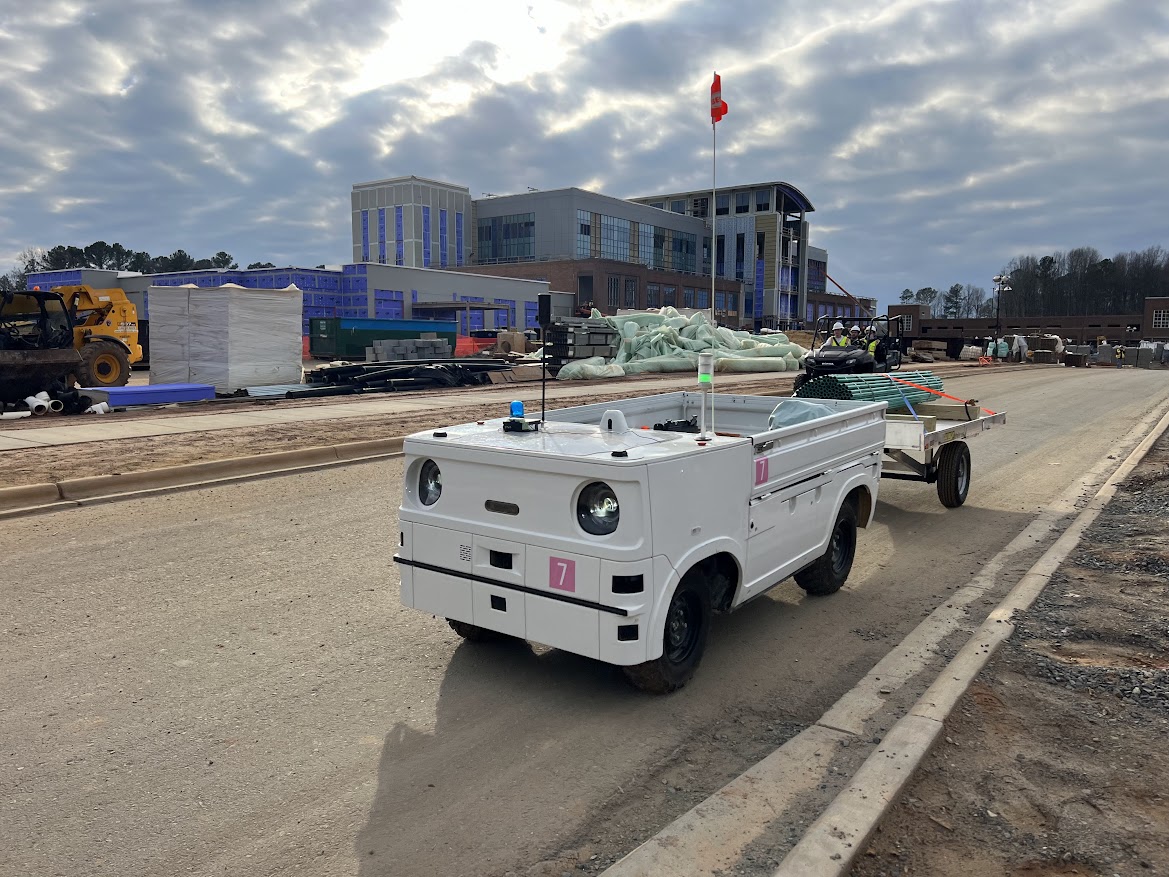The concept of self-driving cars has often held fascination in predictions of the future, but for years, true autonomous operation was only a fantasy. As the technology has become viable, the fascination has resurfaced, and industries, including construction, have turned their attention to harnessing the power of autonomous solutions.
In January, Robins & Morton’s CaroMont Regional Medical Center Belmont project in Charlotte, North Carolina, had the rare opportunity to evaluate the Honda Autonomous Work Vehicle (AWV), putting the application of this technology to the test.
Honda’s AWV is an all-electric off-road vehicle that can be controlled remotely or programmed to operate autonomously following a pre-programmed path, including pickup and drop-off points. For autonomous operation, its various sensors use GPS to determine location, radar and LiDAR to detect obstacles, and stereoscopic 3D cameras to enable remote monitoring.
The field test at CaroMont Regional Medical Center Belmont is a result of a new collaboration between Robins & Morton and Honda, which began in 2022. Honda has been developing the AWV to support construction-related activities, and its product team reached out to Robins & Morton about testing the vehicle in real-world conditions.
Recognizing the potential value of such an opportunity, Robins & Morton leadership met with Honda to learn more about the AWV and discuss details of a collaboration.
After a visit to Honda’s research and development facility in Raleigh, North Carolina, to see an in-person demonstration of the AWV, Robins & Morton hosted the Honda team at three Charlotte-area projects to find an ideal testing environment, ultimately choosing CaroMont Regional Medical Center Belmont.
CaroMont Regional Medical Center Belmont is a campus project featuring a 256,000-square-foot greenfield hospital, a parking garage and a medical office building. It was selected to test the AWV because the sitework package was far enough along to provide ideal road conditions.
Once the project was chosen, Honda scheduled the AWV for delivery and Director of Corporate and Operational Technology David Pratt and Technology Implementation Coordinator Christina Till planned their trip to Charlotte. After they arrived, they met with the Honda test team and Belmont project team members. Everyone was eager to see the new technology in action.
After an initial safety training, the Honda team explored the project site and showed Till the in-depth functions of the AWV, which helped determine how it operates autonomously.
Testing focused on two major objectives: determining how the vehicle would respond to site conditions and how it could best be used by construction crews. Because the jobsite is always changing, and vehicles and equipment are continuously on the road, it was important to determine if the AWV would successfully interact with those elements – and how workers would interact with the AWV. CaroMont Regional Medical Center Belmont Superintendent John Burleson noted that intersections posed challenges because, while the AWV stops or navigates around obstacles in its pathway, the vehicle isn’t currently programmed to respond with the human equivalent of common courtesy. Since the vehicle is a prototype, these types of observations are helpful to progressing the AWV’s functionality to make the vehicle as safe as possible.
To determine what materials the vehicle could carry as well as how much it could carry, the team tested it with common construction materials, including conduit, bricks, and wet sand to simulate mortar. The Honda team brought along a custom trailer that attaches to the AWV for added capacity. These trial runs also helped Honda assess the vehicle’s loading options and determine which option would be beneficial for construction personnel.
The testing process also shed light on common features any vehicle would have, such as turning radius, as well as features specific to the AWV’s technology. For example, Robins & Morton was interested to see if the AWV would maintain its cell connection during its work on site, particularly in the parking garage, where concrete might pose an obstacle to service. Honda meticulously documented the testing and the results. “It was a great experience with technology that holds tremendous potential for our industry,” said Till.
“In the beginning, some team members had concerns that the AWV would be replacing a human worker on the project, but they quickly understood that instead of replacing someone, the AWV will ultimately free up our personnel for more complex tasks,” Burleson said. “For example, when the AWV is capable of functioning fully autonomously, our team members won’t have to drive back and forth to deliver materials or handle other repetitive tasks but can instead focus on tasks that require human knowledge.”
That vision of the future is right on target, according to Pratt. “In helping Honda fine-tune the ‘brains’ of the autonomous functionality, we envisioned all of the functions the AWV might be used for,” said Pratt. “Down the road, it will be scalable, depending on the needs. We’ll be able to combine it with different types of equipment – such as street sweepers or forklifts – and the equipment will be modifiable.”
Robins & Morton is one of the first general contractors in the world to have access to this technology. At the time of the Belmont project testing, only a few prototype Honda AWVs have been built worldwide.
In the coming months, Robins & Morton will receive an AWV for three-month stints working on multiple jobsites to further test functionality and identify both challenges and potential new uses.
“I definitely think it’s a good relationship for us to have and to get in on the ground floor with this technology,” said Burleson. “We’re excited to see how it evolves and comes to fruition.”

